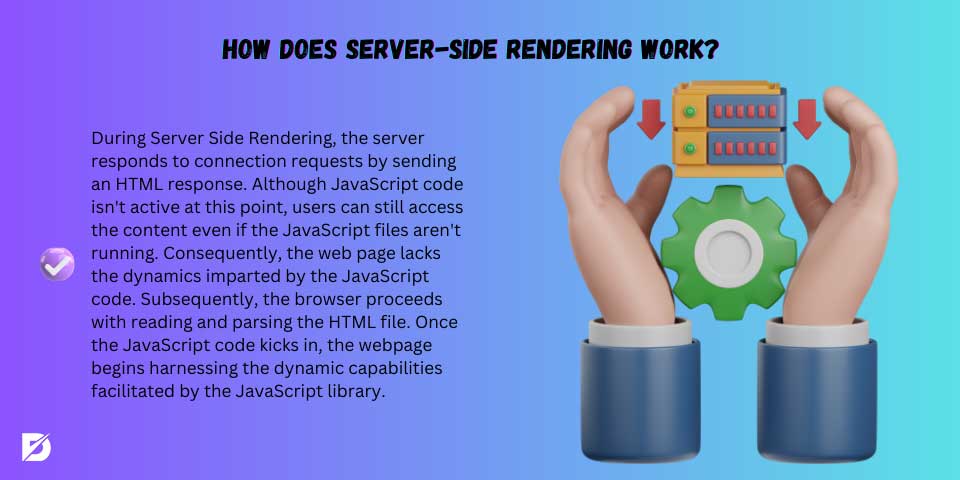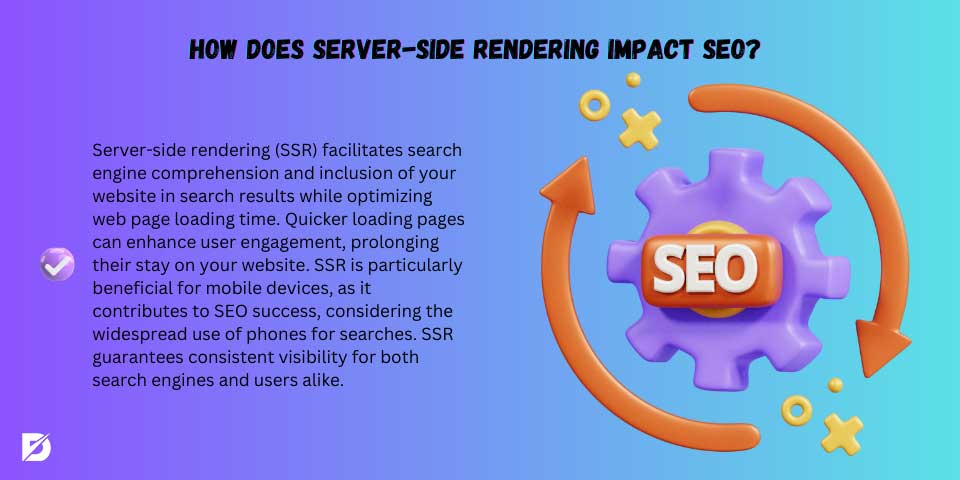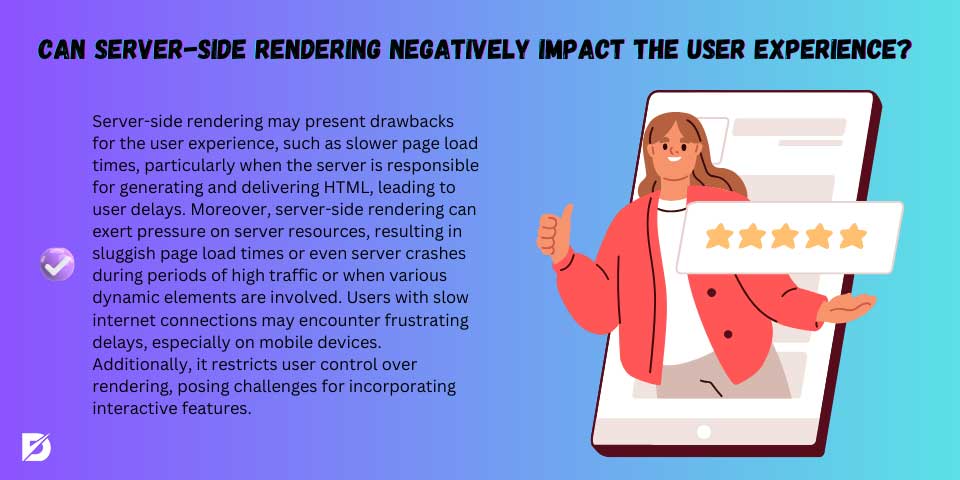Server Side Rendering is the method where the request sent by users to the server is processed on the server side, and the output is transmitted to the browser. In short, it is doing the work of the browser on the server. The working principle of SSR starts with the user making a request. The server receives the request and collects the necessary data. Then, using this data, the server generates a fully rendered HTML version of the page. This HTML file is sent to the browser and viewed by the user. In this process, Server-side rendering uses JavaScript for user-side visual changes and interaction. The dynamic parts or content of the page are generated server-side.
What Is Server-Side Rendering?
In web development, user experience and performance are two significant factors. Therefore, web applications strive to deliver fast load times and impressive user experiences. Server-side rendering (SSR) is a method that helps web developers achieve these goals. Search engines are an essential source of traffic for websites. However, pages built with client-side rendering can have difficulty indexing by search engines. Search engines cannot execute JavaScript code to render the web page. By using SSR, you render your web page on the server side, making it better indexable by search engines. This is important for generating organic traffic (SEO).

How Does Server-Side Rendering Work?
In Server Side Rendering, an HTML response is sent to the connection requests received by the server. JavaScript codes are not active when the HTML response is sent back, but the content can be read by the user even if the JavaScript files are not running. In this case, the page does not have the dynamics provided by the JavaScript code. The browser then starts reading and parsing the HTML file. The JavaScript code is then activated, and the page starts to use the dynamic advantages provided by the JavaScript library. This system allows pages to load quickly while minimizing the JavaScript code running in the user’s browser.
When a user enters a URL into their browser and requests the page, the server receives the request and collects all the data for that page. This data is combined with many components on the server-rendered, and the result is an HTML file. This HTML file is then sent to the browser and displayed to the user. The working process is listed below:
- The user opens a URL in their browser.
- The browser sends a request to the server.
- The server receives the request and collects the data of the relevant page.
- The data is combined with the components available on the server and rendered as an HTML file.
- The rendered HTML file is sent to the browser and displayed to the user.
The Advantages Of Server-Side Rendering
Server-side rendering is a technique to increase the performance of web applications, improve the user experience, and achieve better rankings in search engines.
Some of the advantages of SSR are as follows:
- Content reaches to the user faster.
- Improves SSR SEO performance.
- Allows frontend and backend developers to work at the same time.
- All pages are crawled and indexed, and custom metawork is done for each page individually.
- SSR improves the user experience by making pages load faster. This keeps visitors coming back to the website.
- One of the crucial advantages of SSR is that during the initial loading, the user is not waiting for a blank page, as in Client Side Rendering. Pages fill up quickly.
- There is less JavaScript dependency.
- It helps the page load even if the user’s device is outdated.
The Disadvantages Of Server-Side Rendering
One of the disadvantages of Server-Side Rendering (SSR) is that it can make the server work harder, which may slow things down. It can also be more complicated to set up and could limit how interactive your website is. Handling client-side scripts might be challenging, too. So, web developers need to consider these advantages and disadvantages before choosing server-side rendering to ensure it’s the right choice for their project.
Some of the disadvantages of SSR are as follows:
- The number of requests to the server is high. This means more load on the server.
- Server costs are high.
- Interactivity is not as good as Client Side Rendering in applications where speed is important and second-by-second data flows.
- Navigation between pages is slow because all pages are reloaded with each navigation.
What Is Static SSR?
Static Server-Side Rendering (Static SSR) is a method in web development to make websites work better. It is a combination of two important ways to show web pages. When we visit a website, the web server usually makes a web page for us. Static SSR helps websites load quickly, and it’s good for SEO because search engines like Google can understand the website better. It also makes the website easy to grow because it can serve many people at once. In addition, it’s a common choice for blogs, marketing sites, and e-commerce product pages. The big difference with Static SSR is that web pages are created and saved in advance as static files. So they’re ready to show without the server doing extra work when someone asks to see them.

How Does Server-side Rendering Impact SEO?
Server-side rendering (SSR) helps websites become more visible to search engines like Google. This is important for SEO, which makes your website appear well in search results. Search engine optimization (SEO) is a key part of building websites and creating content. Server-side rendering (SSR) is a big deal in how well your website does in Search engine optimization.
SSR impacts many things, like how fast your pages load, how well your content shows up, and how users engage with your site. Knowing how SSR affects SEO measures is vital for web developers and marketers who want their websites to do well in search engine results.
- Better for Search Engines: SSR makes it easier for search engines to understand and include your website in search results.
- Faster Loading: Makes your web pages load faster. SSR is good for SEO because search engines like websites that load quickly.
- Lower Bounce Rates: Faster loading pages can keep people on your website longer.
- Works Well on Mobile: SSR helps your website work well on mobile phones since it’s important for SEO because many people use phones to search.
- Accessible for Everyone: SSR can make your website more accessible for people with disabilities, which is a positive for SEO.
- Consistency: SSR ensures that what search engines see is the same as what people see.
Using server-side rendering for SEO is that it lets you use extra information to make your eCommerce site show up better on Google. This extra information often includes things like frequently asked questions (FAQs), customer reviews shown when people search for your site, and contact details. These added details can help your site rank higher on Google and attract more customers.
Does SSR help Core Web Vitals?
Yes, Server-Side Rendering (SSR) can help improve Core Web Vitals, which are a set of user-centered metrics that measure the loading performance, interactivity, and visual stability of a web page. One of the most important metrics tracked in page speed performance and Google search results is Core Web Vitals. It takes into account metrics such as load speed, interactivity, and visual stability. If a page has Server-Side Rendering (SSR), it will have an impact on Core Web Vitals values and Pagespeed performance.
SSR can positively impact these metrics in the following:
- Largest Contentful Paint (LCP) is one of the three most important data of core web vitals, one of Google’s most important ranking metrics. With Server Side Rendering, the element determined as LCP on the page will load much faster on the browser side. So, you can achieve much more successful results in the LCP score measured by Google.
- Cumulative Layout Shift (CLS) is another important core web vitals metric Google tracks. It measures the amount of unexpected change in the size and position of your content elements after the page is first created.
- First Input Delay (FID) is another one of Google’s important core web vitals data. Server Side Rendering generally provides an advantage in optimizing core web vitals data. But when FID scores are taken into account, Server Side Rendering can negatively affect FID scores depending on technical conditions.
Is Server-Side Rendering Better for SEO Than Client-Side Rendering?
Generally, Server-Side Rendering (SSR) means the page is created on the server, and Client-Side Rendering (CSR) means it’s made on your computer. When making a website, you need to choose between these two methods for rendering your web pages.
SSR SEO is generally better than CSR because it facilitates indexing, improves page load speed, enhances mobile friendliness, maintains content consistency, and supports accessibility. However, the choice between SSR and CSR depends on your specific website requirements and goals, as some websites may benefit from a combination of both approaches for the best user experience and SEO performance. The most obvious difference between Server-Side Rendering and Client-Side Rendering is where the javascript files are implemented. Depending on this, there will be a performance difference. To notice the differences between Server-Side Rendering vs. Client-Side Rendering are as follows:
- In the SSR method, JS files are applied on the server, while in CSR management, they are applied by the user.
- In the SSR method, the FCP time, which indicates the time to see the first request at the site opening, is lower than the CSR method.
- The server load is higher in the SSR method than in the CSR method.
- SSR management is more advantageous in terms of SEO.
- The SSR method requires new generation libraries other than traditional javascript libraries, which creates the need for a special team and extra cost.
SSR and CSR each have their advantages and disadvantages. The choice between them depends on the specific features your app requires.

Can Server-Side Rendering Negatively Impact the User Experience?
Server-side rendering can have drawbacks for the user experience. It can lead to slower page loads, especially when the server has to create and send HTML, causing user delays. Additionally, server-side rendering can strain server resources, resulting in slow page load times or even server crashes during high traffic or with many dynamic elements. Users with slow internet connections can face frustrating delays, particularly on mobile devices. Furthermore, it limits user control over rendering, making it challenging to add interactive features. Implementing and maintaining server-side rendering can also be complex and time-consuming, especially for large or evolving applications, impacting development efficiency and the user experience.
Can Server-Side Rendering Improve the Ranking of a Webpage in Search Results?
Yes, SSR provides better SEO performance. This is because a completed HTML page generated by the server can be indexed more easily by search engines. Also, SSR allows for less processing on the user side when serving a server-completed HTML page, which improves server efficiency. However, due to the nature of some applications, they cannot be crawled correctly by search engines because they run in the browser. This poses a significant problem for search engine optimization (SEO). Another advantage of SSR in terms of SEO is the ability to use SEO-friendly URLs. In web applications created with SSR, URLs are more understandable and easier to crawl because the server generates them. This positively affects your site’s ranking in search engines.
Web applications built using SSR have improved search engine indexing, faster loading times, and enhanced user experience. Additionally, SSR allows for the utilization of SEO-friendly URLs, potentially boosting your site’s search engine ranking. Therefore, it is important to pay attention to the impact of SSR on SEO when developing a web application.
Server-Side Rendering and SEO
Server-side processing has many advantages over client-side processing. In particular, they provide significant benefits in terms of performance, SEO, and accessibility. However, since every project is different, you must be careful when deciding which method to use. Although Google improves its capabilities every year, especially in terms of processing and indexing user-side javascript, the cost of elements created with javascript at the point of crawling and storage, and Google’s policy of reducing crawling costs, which is very natural as a company, reducing both indexing and crawling costs by using server-side rendering for the SEO can be very critical success of a project.
Frequently Asked Questions About
Google aims to direct users to websites that load quickly because faster-loading pages receive higher rankings in organic search results.
Search engines might struggle to understand and interpret the content on a website that heavily relies on client-side rendering.
Client-side code is for using HTML, CSS, and JavaScript. It runs within a web browser and usually can’t access the computer’s operating system or the file system.





No comments to show.